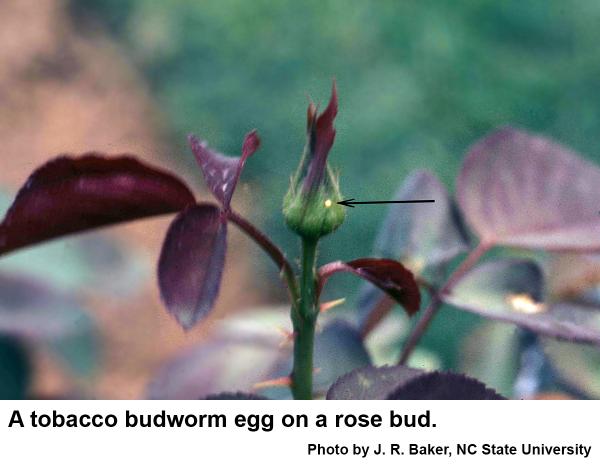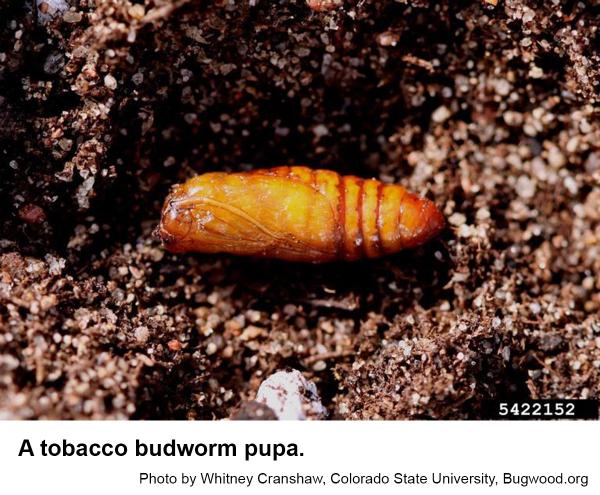Description and Biology
Tobacco budworm moths, Heliothis virescens, are light olive to brownish-olive, with a wingspan of about 1¼ inches. Each forewing bears three slanted, dark olive or brown bands. Hind wings are white with dark margins. Females lay tiny, round white eggs that develop a reddish-brown band just prior to hatching. Newly hatched caterpillars are tiny and yellowish-white with brown heads. With pale stripes running lengthwise on the body, fully developed tobacco budworms are greenish-yellow to reddish-brown and about 1¾ inches long. Tobacco budworm larvae have five or six instars with the development period varying from 21 to 25 days. Mature budworms bore two to four inches into soil to pupate. The pupae are shiny and reddish-brown to dark brown before adult emergence. The fourth generation of budworms overwinters as pupae under ground. Tobacco budworm adults emerge in North Carolina from late April to mid-May, and females generally emerge earlier than males.
Host Plants
Roses, petunias and geraniums are often infested throughout the growing season but tobacco budworms may become more abundant in landscapes in summer and early autumn as tobacco, cotton, and soybeans become less attractive to gravid female moths. Ageratum, bird of paradise, chrysanthemum, gardenia, mallow, marigold, snapdragon, strawflower, verbena, and zinnia are also infested. Vegetables, especially tomato, cabbage, collards, and okra are readily infested. Wild hosts of the tobacco budworm include deergrass, toadflax, cranesbill, dock, vervain, mallow, and beggarweed.
Residential Recommendations
A parasitic wasp, Campoletis sonorensis, kills small budworms. Another parasitic wasp, Cardiochiles nigriceps, kills large budworms. Paper wasps also prey on tobacco budworms. Bigeye bugs,damsel bugs, minute pirate bugs, and spiders also prey on tobacco budworms. Several diseases, including the microsporidian Nosema heliothidis, also impact budworm populations. Because tobacco budworms have many weed hosts that are never sprayed with insecticides, budworms are not likely to be resistant to most insecticides labeled for residential landscape use. It's kind of tricky to control insect and mite pests of roses and other flowering plants because the flowers attract pollinators. Killing pollinators is un-American! However, rose buds can be protected by spraying them with a pyrethroid insecticide. These pesticides have a long residual life that could harm pollinators BUT the residue remains on the outside of the sepals. When the bud opens, the sepals curve downward away from the petals and anthers that attract bees and butterflies. A number of pyrethroid insecticides are now on the market for homeowner use in the landscape. Most big box stores and garden centers carry permethrin, lambda cyhalothrin, bifenthrin, and other pyrethroids.
References
- Common name: tobacco budworm, scientific name: Heliothis virescens (Fabricius) (Insecta: Lepidoptera: Noctuidae). Capinera, J. L. 2012 (Revised). Featured Creatures, Entomology & Nematology, FDACS, DPI, EDIS. Publication Number: EENY-219.
- Insect and Related Pests of Field Crops. Hunt, T. N. and J. R. Baker, editors. North Carolina Cooperative Extension Service publication AG-271.
- Insect and Related Pests of Flowers and Foliage Plants. Baker, J. R. ed. 1994 (revised). NC Cooperative Extension Service pub. AG-136.
- The biology of the tobacco budworm and the corn earworm in North Carolina with particular reference to tobacco as a host. Neunzig, H. H. 1969. North Carolina Agricultural Experiment Station Technical Bulletin 196. 76 pp.
- The eggs and early-instar larvae of Heliothis zea and Heliothis virescens (Lepidoptera: Noctuidae). Neunzig, H. H. 1964. Annals of the Entomological Society of America 57: 98-102.
- Wild host plants of the corn earworm and the tobacco budworm in eastern North Carolina. Neunzig, H. H. 1963. Journal of Economic Entomology 56: 135-139.
- Extension Plant Pathology Publications and Factsheets
- Horticultural Science Publications
- North Carolina Agricultural Chemicals Manual
For assistance with a specific problem, contact your local Cooperative Extension Center.
This Factsheet has not been peer reviewed.
Publication date: May 27, 2016
Revised: Oct. 17, 2019
Recommendations for the use of agricultural chemicals are included in this publication as a convenience to the reader. The use of brand names and any mention or listing of commercial products or services in this publication does not imply endorsement by NC State University or N.C. A&T State University nor discrimination against similar products or services not mentioned. Individuals who use agricultural chemicals are responsible for ensuring that the intended use complies with current regulations and conforms to the product label. Be sure to obtain current information about usage regulations and examine a current product label before applying any chemical. For assistance, contact your local N.C. Cooperative Extension county center.
N.C. Cooperative Extension prohibits discrimination and harassment regardless of age, color, disability, family and marital status, gender identity, national origin, political beliefs, race, religion, sex (including pregnancy), sexual orientation and veteran status.





